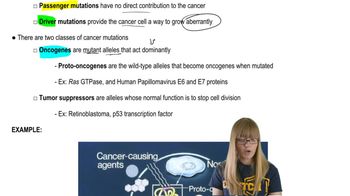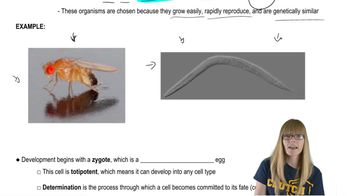Table of contents
- 1. Introduction to Genetics51m
- 2. Mendel's Laws of Inheritance3h 37m
- 3. Extensions to Mendelian Inheritance2h 41m
- 4. Genetic Mapping and Linkage2h 28m
- 5. Genetics of Bacteria and Viruses1h 21m
- 6. Chromosomal Variation1h 48m
- 7. DNA and Chromosome Structure56m
- 8. DNA Replication1h 10m
- 9. Mitosis and Meiosis1h 34m
- 10. Transcription1h 0m
- 11. Translation58m
- 12. Gene Regulation in Prokaryotes1h 19m
- 13. Gene Regulation in Eukaryotes44m
- 14. Genetic Control of Development44m
- 15. Genomes and Genomics1h 50m
- 16. Transposable Elements47m
- 17. Mutation, Repair, and Recombination1h 6m
- 18. Molecular Genetic Tools19m
- 19. Cancer Genetics29m
- 20. Quantitative Genetics1h 26m
- 21. Population Genetics50m
- 22. Evolutionary Genetics29m
14. Genetic Control of Development
Studying the Genetics of Development
Problem 25
Textbook Question
How would you conduct a screen to identify recessive mutations in Drosophila that result in embryo lethality? How would you propagate the recessive mutant alleles?
 Verified step by step guidance
Verified step by step guidance1
Start by selecting a population of Drosophila that is heterozygous for various mutations. This can be achieved by treating flies with a mutagen to induce random mutations.
Cross these heterozygous flies with a balancer stock. Balancer chromosomes are used to maintain recessive lethal mutations in a heterozygous state because they suppress recombination and carry dominant markers.
Screen the offspring for the absence of homozygous mutants. Since the mutation is recessive and lethal, homozygous mutants will not survive, and you will observe a reduction in the expected number of offspring.
To propagate the recessive mutant alleles, maintain the mutation in a heterozygous state by continuously crossing heterozygous carriers with the balancer stock. This ensures that the mutation is preserved in the population without expressing the lethal phenotype.
Periodically test-cross the heterozygous carriers to confirm the presence of the recessive lethal mutation by checking for the expected Mendelian ratios in the offspring.
Recommended similar problem, with video answer:
 Verified Solution
Verified SolutionThis video solution was recommended by our tutors as helpful for the problem above
Video duration:
2mPlay a video:
Was this helpful?
Key Concepts
Here are the essential concepts you must grasp in order to answer the question correctly.
Recessive Mutations
Recessive mutations are genetic alterations that only manifest their effects when an individual has two copies of the mutant allele, one inherited from each parent. In Drosophila, these mutations can lead to specific phenotypic traits, such as embryo lethality, which can be identified through careful breeding and observation of offspring.
Recommended video:
Guided course

Cancer Mutations
Drosophila Genetics
Drosophila melanogaster, commonly known as the fruit fly, is a model organism in genetics due to its simple genome, short life cycle, and ease of manipulation. Researchers use Drosophila to study genetic mutations, inheritance patterns, and developmental processes, making it an ideal subject for screening recessive mutations that affect embryonic development.
Recommended video:
Guided course

Drosophila P Element
Propagation of Mutant Alleles
To propagate recessive mutant alleles, one must perform controlled crosses between individuals carrying the mutant alleles. By mating heterozygous flies (carrying one mutant and one wild-type allele), researchers can produce offspring that segregate the alleles, allowing for the identification and maintenance of homozygous recessive mutants in subsequent generations.
Recommended video:
Guided course

New Alleles and Migration

 8:30m
8:30mWatch next
Master Genetics of Development with a bite sized video explanation from Kylia Goodner
Start learningRelated Videos
Related Practice


